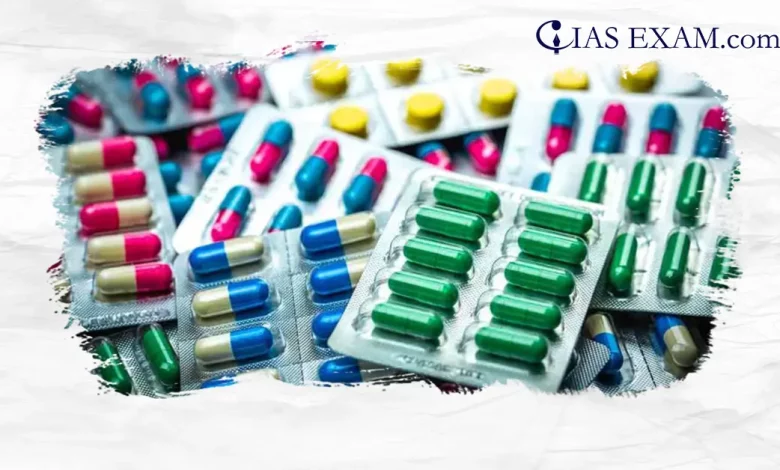
Context
Despite the announcement of H1 rule, no State government had adopted it until Kerala recently initiated Operation AMRITH (Antimicrobial Resistance Intervention for Total Health).
What is Antimicrobial Resistance (AMR)?
- Antimicrobials – including antibiotics, antivirals, antifungals and anti-parasitics – are drugs used to prevent and treat infections in human beings, animals and plants.
- AMR occurs whilst bacteria, viruses, fungi and parasites trade over time and no longer respond to medicines (develops drug resistance).
- This makes infections more and more difficult or impossible to deal with, growing the threat of diseases, intense contamination and loss of life.
- They can spread from person to person or between humans and animals, including from food or animal origin.
- The rapid global spread of multi and pan-drug resistant microorganism – “superbugs,” is mainly concerning.
- As a result, WHO lately recognized AMR as a chief public health chance.
- The main drivers of AMR consist of:
- The misuse and overuse of antimicrobials;
- Lack of access to smooth water, sanitation and hygiene (WASH) for each humans and animals;
- Poor infection and ailment prevention and manage in health-care facilities and farms;
- Poor access to satisfactory, cheap medicines, vaccines and diagnostics;
- Lack of recognition and understanding; and
- Lack of enforcement of legislation.
Issue of antibiotic prescriptions through doctors in India
- It is vital to know that over 50-70% of antibiotic prescriptions by using docs are deemed unnecessary and irrational.
- One of the main reasons for needless antibiotic utilization is the unavailability of laboratory facilities to make an accurate analysis of bacterial infections.
- The other essential motive for needless antibiotic prescriptions with the aid of docs is the stress from patients to get hold of antibiotics.
- Patients wrongly believe that a course of antibiotics is a quick remedy for a fever episode of any cause.
What should be done to curb AMR?
- AMR is a socioeconomic problem and fighting it requires a multipronged approach.
- The measures consist of –
- Improving public health infrastructure, sanitation centers, and governance to be able to lower the transmission of infections and, therefore, the dependence on antibiotics.
- Reformations to physicians’ prescribing practices and mandating that hospitals report healthcare-related infection charges.
- In order to reduce the spread of these infections, healthcare facilities should follow the precise requirements for contamination prevention.
- There must be a system where all hospitals document quotes of health center-obtained infections to the State governments and the information ought to be made public.
- Currently, all NABH (National Accreditation Board for Hospitals & Healthcare) hospitals in India acquire this statistics every month and take measures to lessen clinic-received infections.
- But it is crucial that all hospitals observe in shape and share the facts with the States.
- Other essential measures, along with rationalising antibiotic use in hospitals, banning the growth-promotional use of antibiotics in poultry farms, fish farms, and agriculture based totally on the already existing regulations, are of paramount importance.
- Educating patients approximately the limitations of antibiotics and discouraging them from pressuring doctors for unnecessary prescriptions is essential.
What are the H1 Rules and Their Implementation?
- In 2011, the Indian government introduced the H1 rule to restrict the over-the-counter (OTC) sales of antibiotics without a prescription, responding to the growing concern over AMR.
- However, because of the healthcare device’s heterogeneity across the united states of america, the implementation of this rule faced good sized demanding situations.
- In 2013, following the Chennai Declaration report and initiative by clinical societies in India, the Indian government changed the rule of thumb to restriction the OTC restriction to second-and 0.33-line antibiotics.
- This change was aimed to ensure that life-saving antibiotics remained available to the public, in particular in faraway regions of the country where medical doctors might not be readily available.
- However, strictly implementing the OTC regulation without addressing the opposite problems, which are primary drivers of antimicrobial resistance, may not help the motive.
What is AMRITH and What Facilitates its Implementation in Kerala?
- Kerala’s excessive doctor-patient ratio (even in villages), excessive literacy price allows the enforcement of this rule.
- An informed population is more likely to apprehend the importance of policies and cling to them, facilitating smoother execution and compliance.
- Kerala will do better if
- It needs hospitals to reveal the occurrence of hospital-acquired infections.
- It supports and promotes the improvement of recent antibiotics, diagnostics, and vaccines by entrepreneurs.
- Karnataka and Maharashtra-based startups have accomplished amazing development in this area.
- While it is especially commendable that Kerala is imposing the H1 rule to rein in AMR, it is not going to have a large impact on drug-resistant infections in the near future.
- The results of this initiative may also take several years to occur. However, it’s going to foster a tradition of respecting antibiotics and encourage similar movements to fight AMR.
Source: The Hindu
UPSC Mains practice Question
Q.‘Antimicrobial resistance is one of the huge challenges of modern medicine.’ Discuss. Also suggest some measures to deal with such challenges. (250 Words)





.png)



